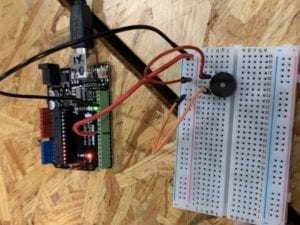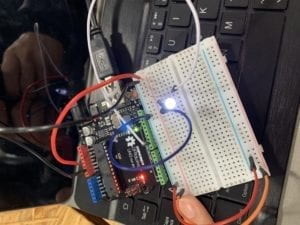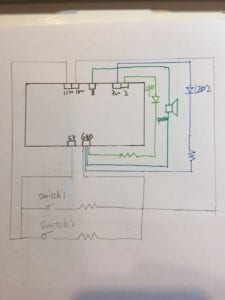Here are the materials we used during the recitation:
1 * Arduino Uno
1 * USB A to B cable
1 * breadboard
1 * buzzer
2 * LEDs
2 * 220 ohm resistors
2 * 10K ohm resistors
2 * pushbuttons
2 * arcade buttons
A handful of jumper cables
1 * Multimeter (optional)
This week we finished three circuits, and they were more complex than the last week.
The first one was relevantly easier than the other two, hence, we finished it quickly. Since we already connected the breadboard with Arduino properly after the first circuit so the second circuit went smoothly by switching only one component. From the process of building the first and the second circuit, I felt much clearer about the construction and function of the breadboard and Arduino than the last week. In addition, I also realized professors’ intention of assigning the first and the second circuits. After all, the process of learning new knowledge is always starting with familiarity.



When came to the third circuit, the process got much more complex, not only the circuit itself, but also the coding part required more effort. Even though the instruction picture was super clear about which line should be connected to which interface, me and my partner still spent a lot of time on making sure we connected them in the right way. However, after we finishing building the circuit, instead of showing up all the data, two LEDs were only lighted up. We were not sure about whether we made mistake on connection or coding. Then, after asking help from the class instructor, we realized that there was a mistype of punctuation, which turned out to be a failure of our circuit. We assumed that it was highly possible that we missed punctuation when we were doing the “copy” and “paste” from the website. Since this problem has been solved through the help of our class instructor, we then moved to our optional task, the fourth circuit, of the recitation.
The last one has its reason to be the optional practice since it was comparatively much more complex than all circuits that I have ever built before. It not only required us to think very hard to connect two breadboards together but also asked for editing the original code to four players’ mode. I was responsible for the physical part which was trying to figure out how to use one Arduino to actuate two breadboards as well as the components on them. Even though we tried so many times, after connecting every component together, our game still failed in the end. There was one button which was player two that failed to be connected to the right position. No matter how many times we pressed, the data kept not changing. We could not be sure where was wrong, but we still got a slight taste of how complex the IMA projects could be.
Question 1
Talking about technology, I think there is a very important point of view in the text which is the distraction level of technology. Nowadays, technology has reached every part of our lives. However, our impression is always based on whether they are user-friendly, and neither have we thought about how the simply computing process becomes more and more user-friendly. In other words, the interaction happens when people do not pay attention to. For example, the Arduino we use during class is already a user-friendly product. We almost do not need to create new codes for completing circuits, we find certain code samples to match the requirements instead. Technology is becoming more and more aware of what people need and how people would like to get it. This is already a process of interaction.
Question 2
If I have 100,000 LEDs of any brightness and color at my disposal, the first question comes into my mind is how to deal with the power that these LED need. If I have to use wires to connect them with power, I have to make sure they are not too far away from each other. After having this conclusion, I already limit my project into a certain area. I want to collect them together and use them to build a project which can show how brightness just 100,000 LEDs can bring. I hope people can realize how much energy we are consuming every day and how much impact we have done to nature every day since our technology starts growing fast. I want to place this project at a museum so that it can be more educational.